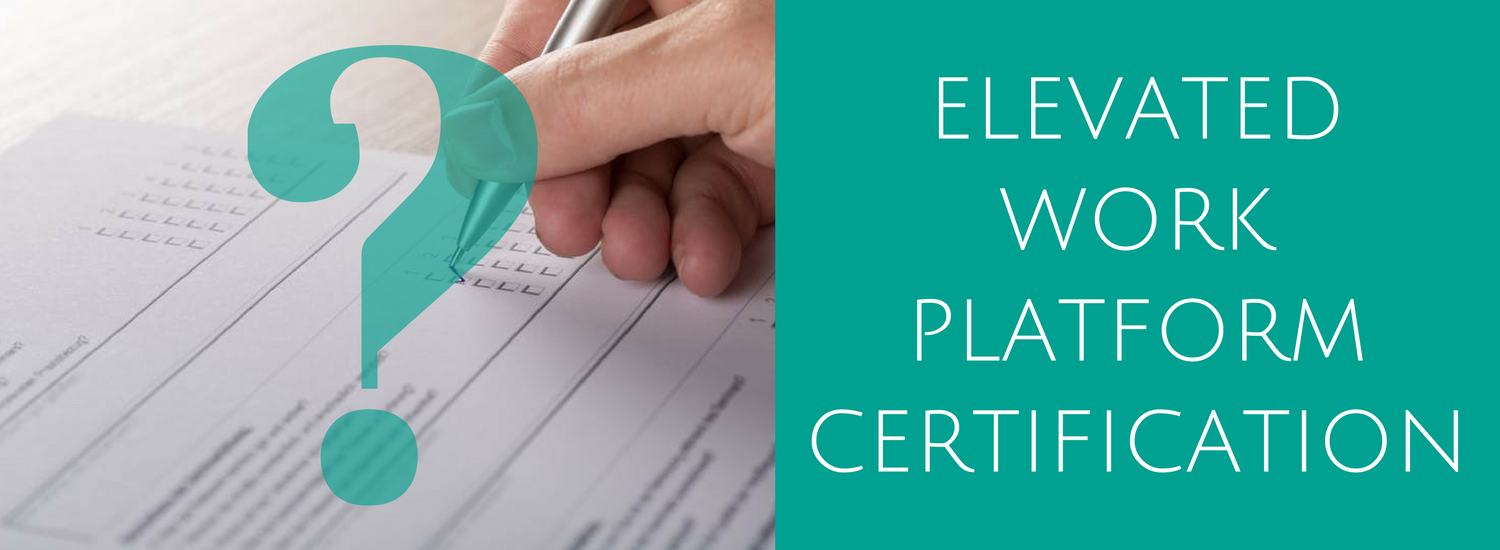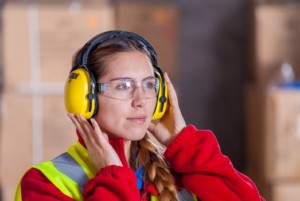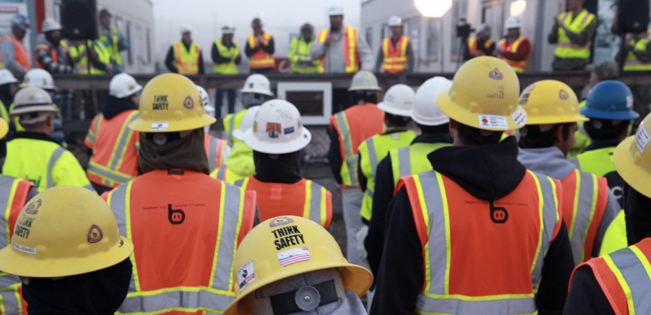
Looking for more information on elevated work platform certification? Elevated work platform training, also called elevating work platform training or aerial lift training, is important for anyone who will be working with or around elevating work platforms (EWPs).
This page provides information about the realities and misconceptions surrounding elevated work platform certification. Are you looking for more information about EWP training or health & safety training for your workplace? Contact the experienced trainers at ACUTE today!
Elevated Work Platform Certification

Some safety training courses receive government certification/approval. This is the case for the MLITSD required Working At Heights training course. Completing a certified Working At Heights training course is legally required for those working from heights on construction projects.
ACUTE’s Working At Heights training program has been approved by the Chief Prevention Officer under the Ministry of Labour, Immigration, Training and Skills Development’s Working At Heights Training Program Standard and the Working At Heights Training Provider Standard. Working At Heights training is valid for three years, and then refresher training is required.
“The Occupational Health and Safety Awareness and Training Regulation (O. Reg. 297/13) requires that employers ensure that workers on construction projects successfully complete a working at heights training program if those workers are required by the Construction Projects Regulation to use specified methods of fall protection (travel restraint system, fall restricting system, fall arrest system, safety net, work belt, or safety belt).
The program must be approved by the Chief Prevention Officer (CPO) and must be delivered by a training provider approved by the CPO (sections 6 and 7 of O. Reg.297/13). Employers must also keep a record of the working at heights training and make it available to an inspector on request (section 10 of O. Reg. 297/13).”

Unlike Working At Heights (WAH) training, elevated work platform training does not require the same certification. There is also no official expiry for elevated work platform training. For best safety practices, it is recommended that workers receive elevated work platform training or refresher training every year to ensure the safety of workers, employers, supervisors, and everyone else in the workplace.
However, there are different certification requirements and obligations for elevated work platforms under the OHSA and the Construction Projects Regulation.
It states:
“The elevating work platform must comply with the applicable National Standard of Canada as set out in O. Reg. 213/91. A professional engineer must have certified in writing that the elevating work platform is in compliance with the applicable National Standard. The certificate provided by the professional engineer must include the details of testing carried out on the elevating work platform and outlined in the standard
[O. Reg. 213/91, section 144].”Unlike WAH training, companies cannot be MLITSD certified specifically for elevating work platform training. Still, there are many specific requirements outlined by the MLITSD and OHSA to ensure workers are properly trained.
Specific Training Requirements For Elevated Work Platforms
There are different training requirements outlined by the MLITSD depending on the nature of the work. There are specific rules and regulations for those working in industrial establishments, as well as specific rules and regulations for those working on construction projects.
General Training Requirements
- Those operating EWPs must be provided with the appropriate information and instruction regarding how to safely operate the specific class of EWP they will be using in the workplace. Training should also include the manufacturer’s instructions.
- In order to ensure competence and safe work practices, periodic refresher training is highly recommended.
- When a worker completes training, they will receive proof of training. Workers should keep a copy of this proof of training on their person or at an accessible location in the workplace.
- Employers should also keep a record of operator and employee training in the workplace.
Source – Ontario Ministry of Labour, Immigration, Training and Skills Development
Specific Requirements For Construction Projects
There are specific training requirements for using an EWP on construction projects to help ensure the safety of all workers involved.
- Employers must ensure that workers complete a CPO-approved Working At Heights training course delivered by a CPO-approved trainer. Employers must keep a record of completed training, and be willing to provide records to an inspector if needed.
- (section 26.2 (1) of O. Reg. 213/91): Employers must ensure that workers who use fall protection equipment are adequately trained to use fall protection equipment. Workers must be given adequate oral and written instructions provided by a competent person.
- (section 147(1) of O. Reg. 213/91): Before workers use EWPs, they must be given adequate oral and written instruction on how to properly operate the machinery. They must also be trained to operate the specific class of EWP they will be using in the workplace.
- (section 147(2) of O. Reg. 213/91): Elevating work platform training must include:
> The manufacturer’s instructions
> Instructions regarding load limitations
> Instructions regarding proper use of all controls AND a hands-on demonstration
> Instructions regarding the limitations on the kinds of surfaces the EWP is designed to be used on.- Training should also include information about the specific workplace hazards workers may face and an evaluated demonstration by the worker showing safe operation skills.
Source – Ontario Ministry of Labour, Immigration, Training and Skills Development
Specific Requirements For Industrial Establishments
There are specific training requirements for using an EWP in industrial establishments to help ensure the safety of all workers involved.
- (section 79 of Reg. 851): Before wearing protective equipment or devices (for example, fall protection equipment), workers must receive information and instruction on how to use it and care for it.
- (section 51(2)(a) of Reg. 851): An EWP or lifting device can only be operated by a competent person or by a worker who is accompanied by a competent person.
Source – Ontario Ministry of Labour, Immigration, Training and Skills Development
Looking for EWP training now?
ACUTE’s Elevating Work Platform Training – Course Outline
Because each workplace is different and has specific hazards, EWP training is often specifically tailored to your workplace. With ACUTE’s Elevating Work Platform training course, there are two components: theory and practical.
During the theory component, participants will learn about all classes of elevating work platforms. However, the practical component covers only the type of EWPs the worker will actually be using in the workplace.
Anyone who works with or around elevating work platforms should complete this training course. This includes those in supervisory positions.
ACUTE’s EWP training course includes:
- Classroom interaction with experienced instructors
- Exploring legislative requirements
- Demonstration and hands-on training on a specific class of EWP
- Safe operating procedures
- Inspections
- Class-specific skill testing
- Hazards and safe work practices
- And More!
Help Create a Safer Workplace Now!
Though there are not the same certification requirements for EWP training as for WAH training, working with a qualified and experienced training company can help ensure you and your workers stay safe in the workplace.
ACUTE helps organizations understand their training challenges while also providing unparalleled tailoring and customer service. Here are just a few things you can expect when training with ACUTE:
- Open Door Instructor-Student Partnership – ACUTE’s training services emphasize client participation. Staff want to build relationships with clients and serve as a touchstone for advice anytime moving forward.
- Serving Your Team and Industry – With a vast array of clients in manufacturing, construction, health, academic, and government agencies, ACUTE brings the best safety practices from across the spectrum to your workplace.
- 100 Years Combined Experience – ACUTE provides comprehensive health and safety training, on-site safety services, and consulting services. With over 100 years of combined experience, our staff offer more than theoretical or abstract ideas. ACUTE offers solutions.
- Track Record of Success – ACUTE is rated 4.9/5 stars on Google reviews, demonstrating a commitment to our clients, quality, and passion for training.
ACUTE is located in Waterloo, Ontario and services customers from the cities such as Toronto, Mississauga, Brampton, Hamilton, Milton, Kitchener, London, Guelph, and other cities from across Ontario.
“We have used Acute Environmental & Safety Services Inc. for many years and our personnel always come back well trained, energized and bringing lots of ideas. They are provided with substantial and in-depth knowledge together with challenging opportunities to put into practice what they have learned into our field operations.”
– Dante, Environmental Service Company – Read More Testimonials Here!






